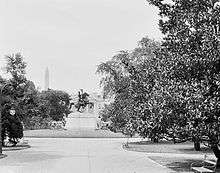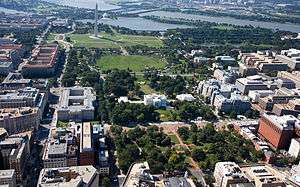Lafayette Square, Washington, D.C.
| Lafayette Square | |
|---|---|
|
Aerial view of Lafayette Square (foreground). | |
 Location within Washington, D.C. | |
| Location | Washington, D.C. |
| Coordinates | 38°53′58″N 77°02′12″W / 38.899508°N 77.036558°WCoordinates: 38°53′58″N 77°02′12″W / 38.899508°N 77.036558°W |
| Area | 7 acres (2.8 ha) |
Lafayette Square is a seven-acre (30,000 m²) public park located within President's Park, Washington, D.C. directly north of the White House on H Street, bounded by Jackson Place on the west, Madison Place on the east, and Pennsylvania Avenue. It is named for the Marquis de Lafayette, a hero of the American Revolution, and includes a prominent statue of early 19th century President and general Andrew Jackson on horseback. The square and the surrounding structures were designated a National Historic Landmark District in 1970.
History
Planned as part of the pleasure grounds surrounding the Executive Mansion, this square was originally called "President's Park", which is now the name of the larger National Park Service unit which includes the White House Lawn. In 1804, President Thomas Jefferson had Pennsylvania Avenue cut through that park, separating what would become Lafayette Square from the White House grounds. In 1824, the park was officially renamed in honor of the Marquis de Lafayette, the French military leader whose involvement was crucial in securing victory in the American Revolutionary War.
Lafayette Square has been used as a racetrack, a graveyard, a zoo, a slave market, an encampment for soldiers during the War of 1812, and many political protests and celebrations. In 1851, Andrew Jackson Downing landscaped Lafayette Square in the picturesque style. On February 27, 1859 Representative Daniel Sickles killed Philip Barton Key II in Lafayette Square. Key had come to the park for an assignation with Sickles' wife, only to be discovered and killed by the congressman.[1]

Today's plan, with its five large statues, dates from the 1930s. In the center stands Clark Mills' equestrian statue of President Andrew Jackson, erected in 1853. In the four corners are statues of foreign Revolutionary War heroes: Major General Marquis Gilbert de Lafayette[2] and Major General Comte Jean de Rochambeau of France, Brigadier General Thaddeus Kosciuszko of Poland, and Major General Friedrich Wilhelm von Steuben of Prussia.
Thomas and Concepcion Picciotto are founders of the White House Peace Vigil, the longest running anti-nuclear peace vigil in US history, at Lafayette Square.[3][4]
References
- ↑ http://www.washingtonpost.com/express/wp/2015/05/15/a-few-bad-days-in-washington-d-c-history/
- ↑ "Major General Marquis Gilbert de Lafayette, (sculpture)". Inventory of American Sculpture, Smithsonian Institution Research Information System. Smithsonian American Art Museum. IAS DC000217.
- ↑ The Oracles of Pennsylvania Avenue
- ↑ Colman McCarthy (February 8, 2009). "From Lafayette Square Lookout, He Made His War Protest Permanent". The Washington Post.
External links
| Wikimedia Commons has media related to Lafayette Square, Washington, D.C.. |



